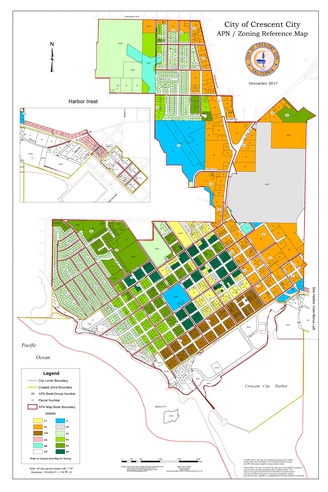Jessica Cejnar Andrews / Monday, April 24, 2023 @ 2:50 p.m. / Homelessness, Infrastructure
Emergency Shelters Will Be Allowed In Crescent City's Commercial Zone w/o a Permit

Emergency shelters will be allowed by right in Crescent City's general commercial zone, shown here in orange. | Map courtesy of Crescent City
Emergency shelters with up to 30 beds will soon be allowed to operate in Crescent City’s general commercial, or C-2, zone without having to obtain a conditional use permit.
Three members of the Crescent City Council last week authorized staff to move forward with amending the zoning ordinance Their direction rectified a concern Mayor Pro Tem Blake Inscore shared in December about the dearth of areas within city limits where emergency shelters could operate by right.
It also brings Crescent City into compliance with Assembly Bill 2339, which took effect Jan. 1 and expands the definition of emergency shelters to include navigation centers, transitional housing, respite and recuperative care, according to Ethan Lawton, of SHN Consulting.
Emergency shelters are currently allowed without a conditional use permit in the city’s public facilities zone, which includes the Del Norte County Fairgrounds, the Crescent City Police Department, the Crescent City Fire Hall and Crescent City Hall.
At the Council’s April 17 meeting, Lawton told them that access to services and amenities played a significant role in determining where emergency shelters should be allowed.
“C-2 is where most services are located and it’s along the 101 corridor,” he told councilors.
There are about 10 acres of vacant land in the C-2 zone with 22 developable parcels, Lawton said. This analysis doesn’t include any commercial buildings or other structures that could be converted to an emergency shelter, he said.
This zoning amendment will be included in the city’s 6th Cycle Housing Element, which has been submitted to the California Department of Housing and Community Development for review.
On Dec. 5, when the City Council weighed in on the 6th Cycle Housing Element, Inscore said the public facilities zone didn’t “offer any kind of meaningful use for emergency shelters.”
Last week, Inscore urged city staff to have a list or a map that shows the undeveloped areas that could be used for an emergency shelter. He also asked for a list of structures that could potentially be used for emergency shelters.
“That would be good knowledge to have if somebody asked us, ‘Well, so what? If this happens, where could this be?’” Inscore said. “I would like to have a map that shows where these undeveloped areas are — maybe it could be a highlighted thing — and the possibility of any structures currently that would fit (the definition). I think from a public engagement standpoint from trying to help educate would be helpful.”
According to the 2022 Point-in-Time report, 462 individuals experienced homelessness in Del Norte County. Of those, 88.3 percent were chronically homeless and 15 percent are veterans.
Currently, Mission Possible Home and the Legacy House offer housing for those experiencing homelessness.
Mission Possible Home is a six-bed facility operated by Del Norte Mission Possible and provides housing to low-risk homeless women with pre-existing health conditions, according to the city’s staff report. Its H Street structure is in the city’s low-district residential zone.
The county operates the Legacy House, formerly the Coastal Inn and Suites, in the general commercial zone. Currently undergoing renovations, the Legacy can only operate at half capacity — about 17 beds, which are full.
Once the renovations are finished, the Legacy House will offer permanent housing, reducing the number of emergency shelter beds to zero, according to the city’s staff report.
CLICK TO MANAGE